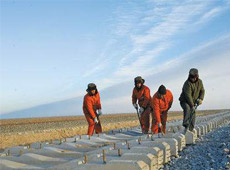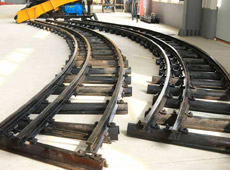

Wooden Sleeper

-


-
Wooden Sleeper
-
0.000.00
-
In general, the timber sleepers lay on the ballasts, and the steel rails are fixed on these railway timber sleepers so that ensuring the safety of the train. On the other hands, the timber sleepers hold the steel tracks at the right position and keep them in a correct gauge. What’s more, the railway sleepers could reduce the vibration of the rails to some degree.
Characteristics of Timber (wooden) sleeper
Wooden sleepers are the first one used in railway and still being used now.Advantage of Timber (wooden) sleeper
With good elasticity and insulation, they're lightweight and easy to connect with rails, convenient for transportation, laying and maintenance.Disadvantage of Timber (wooden) sleeper
Wooden sleepers are vulnerable to mechanical damage with the feature of non-refractory and non-corrosive. They have a short service life but with high costs.Chinese national standard for Wooden sleeper
In China, normal wooden sleepers that can be used for standard railroad are Type I and Type II. The end of Type I sleeper is a rectangle with the length of 2500mm, the width of 220mm and the height of 160mm.Other types of wooden sleepers can be designed according to the needs.Its short service life is mainly because of corrosion, mechanical damage and cracking. In order to extend its service time, China’s railway institute requests the wooden sleeper need to be treated with anticorrosive processing.
Standard for the failure of wooden sleeper
Corrosion – losing pressure bearing capacity and cannot hold nails.
Broken – cannot maintain the gauge
Thickness – less than 140mm
sales@chinasleepers.com
+86-15256911480
GET IN TOUCH









-
Los Angeles Subway Renovation Project
In May of 2018, Ruihe plant started a business with SCJV from USA on the project of LA subway project. Ruihe is the only manufacturer to get the certificate of AC 157F-485 issued International Accredi......
-
Argentina Belgrano Freight Railway Renovation Project
In July of 2015, Argentina representatives for Belgrano freight railway project came to visit Weihai Ruihe Railway Sleeper Co.,Ltd, and appointed Ruihe as the sole manufacturer of this project.With in...
-
Reconstruction Project for Belgrano Freight Railway in Argentina
Weihai Ruihe Railway Sleeper Co., has participated the 1st phase of reconstruction project for Belgrano freight railway in Argentina. Our sleeper products have successfully passed the Acceptance and s...
-
Testing ties manufactured by Ruihe have passed all the qualification tests, and meet the needs of American customers. In December of 2018, Ruihe has been informed to conduct batch production.Figure be...
- South of Changjiang village in Mishan town
- sales@chinasleepers.com
- +86-15256911480

















